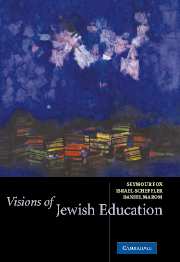Book contents
- Frontmatter
- Contents
- Preface and Acknowledgments
- About the Mandel Foundation
- Introduction
- Part I The Visions Project
- Part II Visions in Detail
- Introduction
- 4 What Must a Jew Study – and Why?
- Supplement: Isadore Twersky
- 5 Jewish Studies in Israel from a Liberal-Secular Perspective
- Supplement: Menachem Brinker
- 6 We Were as Those Who Dream: An Agenda for an Ideal Jewish Education
- Supplement: Moshe Greenberg
- 7 Reflections on the Educated Jew from the Perspective of Reform Judaism
- Supplement: Michael A. Meyer
- 8 Educated Jews: Common Elements
- Supplement: Michael Rosenak
- 9 The Concept of the Educated Person: With Some Applications to Jewish Education
- Supplement: Israel Scheffler
- Part III Visions in Context
- Conclusion: The Courage to Envision
- The Visions Project: Participants and Forums
- Index
Supplement: Menachem Brinker
Published online by Cambridge University Press: 08 January 2010
- Frontmatter
- Contents
- Preface and Acknowledgments
- About the Mandel Foundation
- Introduction
- Part I The Visions Project
- Part II Visions in Detail
- Introduction
- 4 What Must a Jew Study – and Why?
- Supplement: Isadore Twersky
- 5 Jewish Studies in Israel from a Liberal-Secular Perspective
- Supplement: Menachem Brinker
- 6 We Were as Those Who Dream: An Agenda for an Ideal Jewish Education
- Supplement: Moshe Greenberg
- 7 Reflections on the Educated Jew from the Perspective of Reform Judaism
- Supplement: Michael A. Meyer
- 8 Educated Jews: Common Elements
- Supplement: Michael Rosenak
- 9 The Concept of the Educated Person: With Some Applications to Jewish Education
- Supplement: Israel Scheffler
- Part III Visions in Context
- Conclusion: The Courage to Envision
- The Visions Project: Participants and Forums
- Index
Summary
Menachem Brinker's vision departs significantly from any in traditional Judaism. He seeks to change not only the subject matter and teaching methods of Jewish education, but also its assumptions and purposes. Liberated from the obligation to transmit a set of values, beliefs, or normative practices, Jewish education, in Brinker's view, can respect the learner's freedom of thought and cultivate his capacity to arrive at his own approach to Jewish life.
Brinker's version of the ideal curriculum divides the Jewish past into two periods – modern Jewish history (the eighteenth century to the present) and premodern Jewish history (from its origins to the eighteenth century). He emphasizes the study of the modern period, focusing on three areas: Jewish history, Jewish thought, and Hebrew literature.
His vision is based on the Eastern European Jewish thinkers whose writing, in Hebrew, at the turn of the twentieth century demanded a redefinition of Jewish life. They believed that a secular basis for Jewish identity would guarantee Jewish continuity and that the anchor of Jewish existence was not religious but communal. Jews' sense of belonging to a community, their desire to improve the condition of that community, and the will to fulfill themselves as human beings through participation in the community would ensure that Jews continue to define themselves as Jews.
For some of the educators and scholars, the ideas of the Hebrew writers seemed to demand too radical a reorientation of their own convictions about Jewish life.
- Type
- Chapter
- Information
- Visions of Jewish Education , pp. 106 - 121Publisher: Cambridge University PressPrint publication year: 2003



